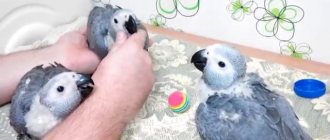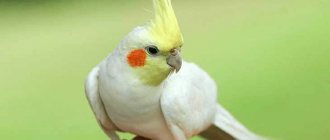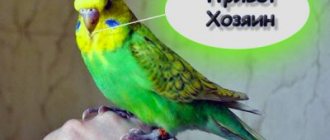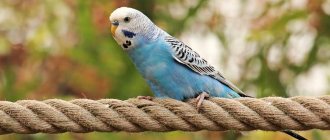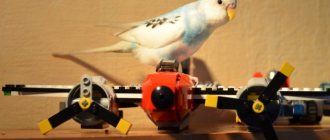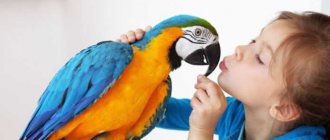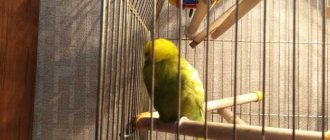Parrots are one of the species of the large parrot family. Representatives of this species include such popular birds among bird lovers as:
- Alexandrian necklace parrot.
- Indian ringed parrot.
- Blue-necked parrot.
It is these representatives of the Ozherelov family that have recently become the most popular among home collectors.
Appearance
These birds are very beautiful. Most representatives have green plumage, with minor splashes of other shades. Representatives of the blue-necked parrot have blue plumage. On the body of these birds, there is one characteristic feature that separates them from representatives of other species of the family - a multi-colored stripe bordering the neck. It is because of this that representatives of the species were called necklaces.
The color of the stripe is different for representatives of different species of necklaces.
Height and weight
Birds belong to the category of medium-sized parrots. Their length ranges from 30 to 60 millimeters. The body weight of zherelovids is from 110 to 125 grams.
The squeaky voice becomes pleasant
Of the species of the necklace genus of parrots, the most talkative are the Indian Cramer's parrot and the Chinese. In nature, they live next door. Their habitats are indicated by their names - India and China. With timely and correct training, these birds can remember up to 100 words from the human vocabulary.
Other representatives - Mauritius, emerald, pink-headed, thread-tailed, Malabar, gray-headed - have not yet shown their abilities. In any case, there are no worthy examples of this.
Owners of necklace parrots note their unpleasant to hear, somewhat creaky voice. However, with mutual friendly communication, the owner very soon gets used to it and even begins to consider it quite beautiful and sonorous.
Spreading
Lives in two parts of the world - Asia and Africa. Its representatives can often be found in South Asia and the African tropics.
A representative of the Ozherelov species, the Indian ringed parrot has the widest distribution among the parrot family. He lives in two parts of the world - Asia and Africa.
In Asia, it is found in India, Pakistan, Nepal, Ceylon, and Myanmar. In Africa, it lives in the lands of Nigeria, Ghana, Burkina Faso, Chad, Ethiopia, Cameroon, Djibouti, Uganda, and Ethiopia.
Friendships are most important
Before you start teaching your necklace parrot various words, you need to carry out appropriate preparation. Remember the following rules:
- the bird must be young (ideally three to six months);
- during classes the pet is kept alone in a cage;
- ensure that there is no extraneous noise (TV running, crackling, popping noises);
- the parrot must be healthy;
- friendly relations have been established between the owner and the pet;
- the necessary stage of taming has been completed;
- After 3-5 years, it is impossible to teach a necklace parrot to speak.
The key to success is the patience of the teacher. Therefore, tune in to a long process and do not expect immediate results. It may take more than one month before you hear the first word from your pet. The process of moving to real conversations can take up to a year.
Diet
Natural food for these birds is all kinds of seeds, vegetables and fruits. A fairly powerful beak allows it to pierce the shell of various fruits, removing and eating their pulp and seeds.
The diet in captivity should be as similar as possible to the natural diet. This means that the feeder must have:
- Seeds and grains.
- Fruits.
- Vegetables.
Rules for teaching parrots to talk
Before you start classes, you need to understand a few nuances:
Rules that will help teach a parrot to talk
- You need to teach the Ozherelov only at the moment when the pet is as calm as possible.
- You cannot speak to him in a raised voice and insult the bird.
- Speech during class must be calm and measured, at an average pace, without harsh sounds.
- The same person must teach. It is advisable that it be a woman or a child, since birds learn high-pitched voices faster.
Next, you need to properly plan your lessons. You need to understand what each lesson should include. First of all, you need to choose words that are convenient for the bird. And learn that the most important thing in this process is regularity.
Duration and lifestyle
At home, the necklace parrot lives up to 25 years. Some experts believe that these birds can live 40 and 50 years. In the wild, life expectancy decreases sharply for a number of reasons:
- Habitat degradation due to deforestation.
- A large number of predatory animals that love to feast on them.
- Poaching.
They prefer to nest in the hollows of tall trees growing in forests. They live in large groups, which can number tens or hundreds of individuals. Early in the morning they fly out in search of food. During lunch they take a short break for rest and sleep. After the break, the search for pasture continues. In the evening they fly to their permanent nesting sites, where they spend the night.
Birds singing is a way to distract from screaming
If you are unhappy with your parrot constantly screaming loudly, try playing music for him. The feathered one will be distracted by the music, his attention will be occupied. By periodically playing the same piece of music, you can teach your parrot to sing songs. When a smart bird hears the same words over and over again, it repeats them, picking up the intonation. Singing is both fun and a great alternative to screaming.
Parrots use their screams to express their emotions, communicate and transmit signals. If you feel that your pet’s behavior is outside the norm, look for reasons not only in him, but also in yourself. Your own balance is the key to a good relationship with a bird.
For those who have a pet, it is no secret that a parrot screams - for him this is a unique way of communicating with his own kind. In their natural habitat, birds use their calls to announce their presence, warn others of danger, and scare away enemies. Domestic birds do not have such a need. The problem arises when the parrot screams constantly. Why this happens and how to properly wean him from screaming will be discussed in this article.
Character and intelligence
By nature, these representatives of birds are sociable, calm and very obedient to their owner. The pets happily greet him every time after a long absence. They rarely show aggression. The owner does not need to fear that the bird will suddenly attack him.
Very curious. Sometimes this can lead to negative consequences. Out of curiosity, they can accidentally damage their beak by hitting it hard on the bars of the cage, break the electrical cable, or peck at things the owner needs.
They love toys. They are especially attracted to small mirrors, into which they can look for hours, admiring their images. It is advisable to hang mirrors within easy reach.
They have a negative attitude towards other feathered pets. They may be aggressive towards those who:
- Weaker and smaller than them.
- Same gender as them.
They immediately try to take a dominant position in relation to other poultry, and do not allow the latter to approach the drinking bowl, feeder, or toys.
Therefore, they can only be kept together in the same cage with equally strong representatives of the species or representatives of larger species that will not allow themselves to be pushed around.
The intellectual level is quite high. They are able to remember and reproduce the sounds of other birds, as well as human speech. Vocabulary varies depending on the species to which the ringtailed parrot belongs. Some species can reproduce up to 60 words, others up to 250. But we must remember that there are species that cannot reproduce human speech at all. The clarity and clarity of their speech depends on individual abilities, as well as the patience and skill of the person who wants to teach the necklace parrot to talk.
Why does the parrot scream
Some birds are especially prone to noise: African Grays, Macaws, Cockatoos. Small parrots, for example, budgerigars, also scream, but for the human ear these sounds are not so sharp. A bird can voice what it feels at the moment. Pets, through a raised tone, let people know that they need something and are worried.
Common causes of screaming:
- the pet has nothing to do, he is bored and lonely;
- living conditions have changed, a move has occurred, or new neighbors have appeared in the cage;
- the bird experiences fear, stress, and is in a state of shock;
- the parrot is hungry, sick and in great discomfort.
Other cases of loud sounds are normal singing, an indicator of a good mood.
The morning calls of parrots are absolutely normal. Even domesticated birds at the genetic level retain the memory of natural biorhythms. Having woken up, the bird sings, clears its throat, and notifies those around it of its awakening. If your client starts screaming in the evenings, he may be overexcited. Birds often meet their owners only before going to bed and express their joy by screaming.
Keeping at home
Keeping these parrots at home is accessible even to novice hobbyists. Breeders just need to follow the rules and pay attention to some important points. If all instructions are followed as much as possible, the necklace pet will live in a cage for a long time and delight its owner.
Selecting a cage and accessories
The first crucial moment is the selection of the optimal cage for keeping. It must meet certain criteria. Firstly, its size must be at least 1x2 meters. The fact is that any type of necklace parrot, be it Mauritian, Indian, Alexandrian or blue, loves space. In a small cage, birds experience serious discomfort, which negatively affects the quality and duration of life.
Secondly, the cage must be made of durable and environmentally friendly materials - wood, modern environmentally friendly plastic, metal. Keeping a pet in a cage whose elements are made of cheap materials that emit harmful substances is unacceptable.
Thirdly, the cage itself must be made of high quality. All sorts of burrs or protruding small nails in the cage can be extremely dangerous for the bird, on which it can be injured.
In addition to the above, cage equipment is extremely important. It should have a feeder and a sippy cup. In addition to them, the presence of perches is mandatory. It is highly desirable if there are several of them. In this case, it is better to place them at different levels, but so that they are not located strictly one above the other.
The bird can jump from one to another and, thus, exhibit motor activity, which is important for any domestic animal. The same requirements apply to perch materials as to cage materials. In addition to the perches, you can place a system of ladders and rings.
Preparing a balanced diet
Proper feeding of a feathered pet is one of the keys to its long and prosperous life. It is advisable to feed him the food that he eats in the wild. First of all, this type of food includes grain.
Therefore, there should always be a grain mixture in the feeder.
It can be made based on:
- Millet grain.
- Oats.
- Canary seeds.
- Sunflower.
Parrots react very positively to various nuts. They love to break through nut shells and get out all the insides, which are then eaten by birds.
The right solution would be to use food additives in the form of vegetables and fruits (tangerine, orange and other citrus fruits). Parrots eat all this in their natural environment.
Therefore, vegetables and fruits are natural food for pets.
Bathing
Initially, washing should consist of carefully spraying the young pet with a spray bottle. The water must be warm. After some time, you can transfer the chick to a full bath. For this purpose, you can use a separate container filled with water about 2-3 centimeters deep.
Education and training
For the first few days of the acquired chick, it is better not to disturb it unnecessarily. The pet has not yet adapted to the new conditions and is experiencing stress. There should always be food and water in the cage. To accustom the chick to your hands, you need to put food on your palm. Usually after 2-4 days the chicks calmly feed from the owner’s hands.
After the chick is tamed, speech training can begin. To do this, you need to take the chick in your arms 2-3 times a day and, raising it to your lips, pronounce phrases loudly and clearly. After a few weeks, the pet will begin to repeat them. The chick should be no more than 3-4 months old.
Diseases and prevention
The main cause of disease is improper care of your pet. Their main external signs are changes in behavior, such as:
- Lethargy.
- Apathy.
- Rapid and intermittent breathing.
- Sleeping on two legs.
If these symptoms are present, it is better to immediately show your pet to a veterinarian to establish a diagnosis and develop a treatment algorithm.
Proper care is the basis for preventing diseases in parrots.
Why does the parrot scream
Some birds are especially prone to noise: African Grays, Macaws, Cockatoos. Small parrots, for example, budgerigars, also scream, but for the human ear these sounds are not so sharp. A bird can voice what it feels at the moment. Pets, through a raised tone, let people know that they need something and are worried.
Common causes of screaming:
- the pet has nothing to do, he is bored and lonely;
- living conditions have changed, a move has occurred, or new neighbors have appeared in the cage;
- the bird experiences fear, stress, and is in a state of shock;
- the parrot is hungry, sick and in great discomfort.
Other cases of loud sounds are normal singing, an indicator of a good mood.
The morning calls of parrots are absolutely normal. Even domesticated birds at the genetic level retain the memory of natural biorhythms. Having woken up, the bird sings, clears its throat, and notifies those around it of its awakening. If your client starts screaming in the evenings, he may be overexcited. Birds often meet their owners only before going to bed and express their joy by screaming.
Reproduction
The process is generally similar to that of other species, but has a number of individual characteristics.
Preparatory procedures
Sexual maturity is reached at 3-4 years. During the mating season, adult birds create pairs. They are stable, but at the same time, partners do not always stay together all their lives.
After mating, they make nests in the hollows of old trees.
Laying eggs and caring for chicks
Egg laying takes 1-2 days. Their number usually does not exceed 4, although according to some data it can reach up to 6. Only the female incubates the eggs. This process lasts 22-24 days. Like other species of parrots, chicks at the beginning of life are completely dependent. The chicks remain in the nest for 6-7 weeks.
About screams.
I’ll start with the fact that the main thing you need to re-educate yourself about is that parrots don’t always “scream.” They sing)) Well, a very quiet, “comfortable” parrot is a sick parrot. If such changes in concepts are not for you, it is better not to get a parrot. All parrots, from budgerigars to macaws, make loud calls and songs. Maybe it's quieter, but that's my personal opinion and experience. (Greys do not have natural songs, like cockatoos, macaws, Amazons or any other species. They grunt, bark, burp, croak, quack, mew, whistle... They can make it very loud, of course, but the semblance of long “songs” in this species There are no parrots to begin with.) And what kind of trills do cockatiels give out... The songs of the male cockatiel and my ears were “sluggish.”
Small parrots, of course, make quieter screams, but many times more often. Large ones, for the most part, do not sing around the clock. Therefore, for me personally, it’s better for a macaw to cry at dawn, and for a cockatoo to “sing” at sunset, because... the rest of the time, if the birds are busy, you don’t hear loud heart-rending... nightingale songs)) from them. Each person has their own threshold for disliking sounds and volume.
In the video: the cockatoo is in a good mood and the whole neighborhood knows about it.
Determination of gender
Up to 3 years of age, gender can only be determined with 100% accuracy using a special analysis. There are several indirect ways to distinguish a boy chick from a girl. A few words need to be said about each of them.
By color and dark ring around the neck
Females are more dull in color. They do not have a “necklace” - a black and pink stripe around the neck.
According to the shape and size of the head, beak
The head of females is more rounded than that of males. The latter are also distinguished by a more saturated color of the cheeks and beak.
By the paws
The paws of female chicks are slightly more powerful and larger than the paws of males. The legs of female birds themselves are somewhat thicker and shorter than those of male chicks.
Tail length
The tail of a male pet is usually slightly longer than that of a female.
By behavior
You need to place a small mirror in the cage and watch your pet. Males, seeing their reflection, begin to show beauty - they constrict their pupils and open their wings. Female chicks behave differently - they tilt their heads back and constrict their pupils in the same way.
Laboratory DNA test
One of all, giving an accurate result. The probability of error is 0.1%. For analysis, it is not necessary to remove the necklace chick from the cage and take the chick to the laboratory. Simply providing a few pet feathers is enough.
The necklace parrot is a very interesting species of bird. Its representatives can be successfully kept in a home cage.
Previous
All typesThe most expensive parrots in the world
Next
All types of Azure parrot and its features
Purchase rules
It is customary to take parrots home when they are very young, so that it is easier for them to get used to their new owner. After the first two months of life, the chick does not need parental care, it becomes independent, and it is at this time that you should buy it. At this age, the bird has a small size, an orange beak, and no necklace, so the likelihood of error is minimal.
- The parrot should be well-fed, with a rounded sternum, smooth plumage;
- A healthy bird is active and curious, a sick bird is apathetic, disheveled, and drowsy;
- A lot of feathers in the cage, undertails stained with droppings are signs of a serious illness. This is not worth buying.
It is recommended to take a ringed parrot for home keeping from a specialized nursery or purchase it from a reputable breeder. Buying from an advertisement or at the poultry market is very risky, as you can buy an individual of the wrong breed, with developmental or behavioral defects.
The pet will be glad to see you
The necklace parrots were not observed to pronounce words and at the same time understand the meaning. Due to their development, birds simply remember frequently heard sounds. This is why you need to communicate and talk more with your pet.
It is best to conduct classes in the morning, while the parrot is not yet tired of the day's worries. Half an hour is enough for mutual communication. But your studies will become more productive if you spend half an hour 2-3 times a day.
Approach the cage and draw the parrot's attention to you. If contact has been previously established, he will be delighted to see you. Start a conversation by saying the chosen word several times in a row. Your intonations should be calm and always the same. At the slightest attempt by your pet to make a sound, encourage him and treat him with a treat.
If you find it difficult to come up with the right word, we suggest using our set from the table:
Don't say bad words
Once the necklace parrot has mastered the techniques of pronouncing words and phrases, it can continue its education on its own. And this will be done both with you and independently of you. Thanks to the ability to imitate the intonation of voices and the timbre of sounds, he can unexpectedly surprise you with the familiar voice of the host of a television program. It is also possible to repeat human speech that is distinguished by some kind of defect (burr, lisp, stutter). And listening to the patient cough too often, he himself will try to “cough.”
So be careful and don’t let your pet remember unwanted sounds and ugly words.
If you read the article with interest, please like it. Don't forget to send the link to your friends.
In the comments, please tell us about your own experience of teaching a necklace parrot to talk.
The developed brain of parrots makes possible all the versatility of their emotions: these birds can be caring and jealous, offended and curious, angry and inspired, demonstratively mischievous and having fun uncontrollably. In nature, birds communicate exclusively with each other, but the life of a tamed parrot is closely connected with humans - and no matter how hard the bird tries, sometimes its rich sound vocabulary remains misunderstood and therefore ignored... Owners of talkers should remember: any chirping, screaming and muttering is always carry a certain semantic load.
If a parrot tweets
The main sounds that a parrot makes include the “peak”, in which in the loudest phase it is easy to hear the “chivik”, reminiscent of a sparrow’s “chirp”. This is the first sound that chicks learn to pronounce when their voice just emerges: this is how they ask to feed them, to pay attention to them. Therefore, even in adulthood, this sound is usually associated with some kind of request from the bird. What the parrot wants to convey to its owner depends on the melody and volume of this sound. If the bird is ignored, the sound becomes louder and sharper.
"Pik" or "piu" said in a calmer tone is usually translated as a question asked calmly and patiently. For example, a bird may use such sounds if its cage is moved to another place for some reason. Or if the owners started rearranging the furniture in the room, the parrot may be slightly perplexed as to why everything is out of place. Or if a person appears in front of a pet in an unusual way - in large sunglasses or, say, with a colander on his head (you never know?)
Parrots are great explorers. They love to organize excursions to little-explored corners of your home and learn something unfamiliar to themselves. So in their vocabulary they have a special sound that the parrot utters without looking up from what it is doing, when it is very good and interesting. It usually sounds like a quiet “chivi-chivi-chivi”, and is repeated periodically after a pause.
In a calm state, a parrot can simply calmly “cheek” - as if whistling, thereby informing those around him that the situation is generally favorable for him, but there is not enough reason for a longer tirade.
If a parrot makes noise...
The parrot's sharp cries, which can be reproduced as “cha-cha! cha-cha!” have different meanings depending on the situation. The parrot may rebel and demand to be let out for a walk. He can “call” a bird he heard outside the window. He can also be excited about something, intrigued to the limit - many birds are brought into a kind of ecstasy by the loud rustling of cellophane and foil, the fall of a spoon or a stack of books from the edge of the table, and other “emergency incidents.” You can encounter such a cry even when the parrot is in an excellent, cheerful and even daring mood. Usually the screams are accompanied by an active cross around the cage, jumping onto the bars and flapping its wings.
Anyone who has ever tried to pick up an untamed parrot has encountered a heart-rending cry of “quack!” The sound can be frightened or indignant, and sometimes resembles a pig squealing. It signals that the parrot wants/demands that you leave it alone immediately. But a parrot makes a loud and sharp single squeak if it is in pain - for example, if it is pecked by another bird. This is, so to speak, a bird's “oh”.
Parrots are prone to both fun and some negative emotions. For example, a parrot, dissatisfied with the behavior of a person or a feathered partner, throws a scandal: it emits a very unpleasant “electric” chatter, which can be described as “piti-piti-piti” with a very elevated intonation, sometimes breaking into a final loud “peak”!
If a parrot sings and coos...
Most of the time, budgies are in a great mood, which they accompany by singing. The parrot takes a comfortable position, most often in front of a mirror or some prominent object such as a nail, a teaspoon, a curl of furniture or another parrot, and begins to sing. In this state, it is better not to touch the parrot - not to spoil its mood. And the song itself, although simple-minded, is quite pleasant to the ear.
Usually the parrot combines sounds arbitrarily, depending on its mood and creative drive. The combination of the sounds “chivik” (but deeper and more melodic) and “chak” gives rise to the famous trill, with which the parrot makes it clear that he is in a good mood and sees life in rosy tones. In general, it sounds like “tuyu-tuyu-tuyu-chuck, tuyu!” This may give the impression that water is babbling. Sometimes the song contains a clicking sound, which in itself is a sign of inspiration.
If a parrot is mumbling...
If the parrot is tired of its own fun, but not yet to the point that it wants to fall asleep, you can hear cooing sounds from it, such as those pronounced quietly and under your breath, with a closed beak, “kwe, kwe-e, kwe-e.” The intonation of sounds decreases. In a sleepy state, talking about how tired he is and how good he feels is reduced to a simple “kyo-yo-yo.”
The funny sound of a bumblebee’s purr, which can be reproduced as “grunt-grunt-grunt”, signals that there is some very pleasant and confidential conversation between two birds - they can feed each other or simply “rustle” with their beaks. Just don’t confuse good-natured grumbling with signs of illness - wheezing and shortness of breath, which occur in lethargic and disheveled birds with dull eyes and poor appetite (such a pet is definitely sick and urgently needs to be shown to a veterinarian).
If the parrot spoke...
As for “speaking,” which is beloved by its owners, this is a valuable additional way of communication for the bird. Most often, parrots speak in a good and calm mood, but they may miss a word or two in some emergency situations or out of place. It is no secret that feathered talkers know how to pronounce words at the right time: the remarkable intelligence of these birds allows them to competently use their vocabulary.
To simplify the task, you should always say the most important moments of interaction with the bird out loud - so that the parrot knows how, if necessary, to convey basic information to a person (eat, drink, swim, walk, home, hello, come to me, it’s time to sleep). This vocabulary can gradually expand - for example, a parrot will learn how to ask for its favorite treat (apple, banana, grass, etc.)
Oh yeah! Necklace parrots can scream. But not everyone yells and not always. The degree of loudness is determined by the character and preferences of each individual bird. It happens that at 6:00 in the morning the necklace parrot screams so much that it can be heard from the top floor all the way down the street.
And I want to calm him down as soon as possible. But how?
To silence a necklace parrot, you need to understand why it screams. And he yells most often when:
• Someone or something is also yelling. If you turn on the TV loudly, it will scream louder than the TV.
• He lacks attention and wants to attract it by shouting. Necklace parrots love communication. So if you are not ready to have frequent contact with the bird, then it is better not to get one. Otherwise, the parrot will loudly send cries into the air, which would mean: “SOS! Save, help! I'm bored!".
• He is dissatisfied with something. Your parrot may not like certain sounds or actions. For example, he may be very indignant if you imitate the sound of a horse clicking its shoes in front of him. My parrot can't stand this - he immediately starts screaming. Watch your pet and over time you will make your own list of what your parrot doesn’t like and what makes him start screaming loudly.
• He simply asks to fly. Necklace parrots do not tolerate confinement in a cage very well. We need to let them fly at least a little.
Accordingly, in order to stop a parrot from screaming, you need to eliminate the sources of irritation that make it scream (loud music, noisy dancing, screaming, etc.) But how to calm a bird down if it screams, and you don’t see any obvious reasons for this? There are several secrets. Remember:
1. Always! Do you hear?! Always cover the cage with a thin black cloth at night. The bird will understand that night has come and will not scream. And this night will last until you remove the fabric. If you don't cover the cage, your favorite parrot will most likely wake you up at first light. And not only you, but also your neighbors. Everyone should know that morning has come! The fabric should be thin so that air can freely penetrate into the cage and the bird does not feel stuffy. Also make sure that the fabric completely covers the cage to the very bottom. If you leave a small part uncovered, the bird will understand that it is being fooled (it is still light outside and you can bawle songs). Necklace parrots are very intelligent.
2. What to do during the day? Yes, it would be somehow wrong to make the bird night during the day. But there is a very effective way: occupy her beak with something tasty. An excellent option is walnut. But the nut is not peeled, but split into two halves. The bird will have to sweat to get the treat from the shell - you are guaranteed at least half an hour of silence. But remember that giving your parrot too many nuts is contraindicated. They are very fatty. I give mine a maximum of 1.5 nuts a day.
3. The Internet rules - even parrots love it. Play a video on the Internet for a necklace parrot where his relatives speak human language, and he will become quiet. He will sit quietly and listen! Moreover, frequent viewing of such videos can teach the bird human speech. Tested from my own experience. My parrot spoke like this.
4. Speak quietly and measuredly. Necklace parrots are designed this way: the louder you talk, the louder they scream. And if you turn up the music at full volume, believe me, the parrot will try to shout over it. And, most likely, he will succeed. So maintain a calm environment at home. Gradually, the bird will get used to it and will try not to violate the volume standards established in your home. If you yourself shout and express negativity, the bird will only get even more excited and will shout down you.
5. Let the bird fly. Outside the cage, necklace parrots rarely scream, since they have a lot of other more interesting things to do - chat with the owner, talk to the reflection in the glass, play with toys, watch videos on the owner’s smartphone, etc. Of course, you will have to make sure that your feathered pet does not misbehave. But he will definitely appreciate your trust and kindness and will respond in kind.
And most importantly, love your pet. Strength and aggression will not achieve anything from parrots.
Only love and patience can turn a wild, noisy parrot into the most affectionate and calm bird that will give you a lot of joy and warmth.
Parrots are one of the species of the large parrot family. Representatives of this species include such popular birds among bird lovers as:
- Alexandrian necklace parrot.
- Indian ringed parrot.
- Blue-necked parrot.
It is these representatives of the Ozherelov family that have recently become the most popular among home collectors.

